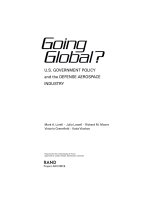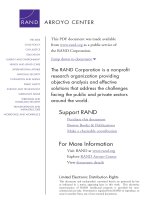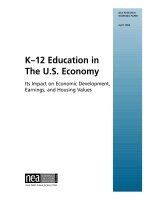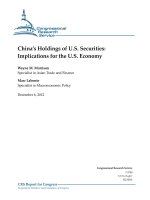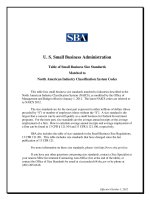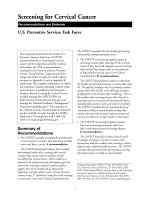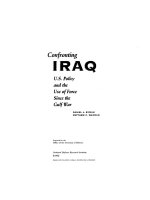U.S. Policy Options for Iraq pdf
Bạn đang xem bản rút gọn của tài liệu. Xem và tải ngay bản đầy đủ của tài liệu tại đây (539.72 KB, 104 trang )
This document and trademark(s) contained herein are protected by law
as indicated in a notice appearing later in this work. This electronic
representation of RAND intellectual property is provided for non-
commercial use only. Permission is required from RAND to reproduce, or
reuse in another form, any of our research documents.
Limited Electronic Distribution Rights
Visit RAND at www.rand.org
Explore RAND Project AIR FORCE
View document details
For More Information
This PDF document was made available
from www.rand.org as a public service of
the RAND Corporation.
6
Jump down to document
THE ARTS
CHILD POLICY
CIVIL JUSTICE
EDUCATION
ENERGY AND ENVIRONMENT
HEALTH AND HEALTH CARE
INTERNATIONAL AFFAIRS
NATIONAL SECURITY
POPULATION AND AGING
PUBLIC SAFETY
SCIENCE AND TECHNOLOGY
SUBSTANCE ABUSE
TERRORISM AND
HOMELAND SECURITY
TRANSPORTATION AND
INFRASTRUCTURE
WORKFORCE AND WORKPLACE
The RAND Corporation is a nonprofit
research organization providing
objective analysis and effective
solutions that address the challenges
facing the public and private sectors
around the world.
Purchase this document
Browse Books & Publications
Make a charitable contribution
Support RAND
This product is part of the RAND Corporation monograph series.
RAND monographs present major research findings that address the
challenges facing the public and private sectors. All RAND mono-
graphs undergo rigorous peer review to ensure high standards for
research quality and objectivity.
Olga Oliker, Keith Crane, Audra K. Grant, Terrence K. Kelly,
Andrew Rathmell, David Brannan
Prepared for the United States Air Force
Approved for public release; distribution unlimited
U.S. Policy Options
for Iraq
A Reassessment
The RAND Corporation is a nonprofit research organization providing
objective analysis and effective solutions that address the challenges
facing the public and private sectors around the world. RAND’s
publications do not necessarily reflect the opinions of its research clients
and sponsors.
R
®
is a registered trademark.
© Copyright 2007 RAND Corporation
All rights reserved. No part of this book may be reproduced in any
form by any electronic or mechanical means (including photocopying,
recording, or information storage and retrieval) without permission in
writing from RAND.
Published 2007 by the RAND Corporation
1776 Main Street, P.O. Box 2138, Santa Monica, CA 90407-2138
1200 South Hayes Street, Arlington, VA 22202-5050
4570 Fifth Avenue, Suite 600, Pittsburgh, PA 15213-2665
RAND URL: />To order RAND documents or to obtain additional information, contact
Distribution Services: Telephone: (310) 451-7002;
Fax: (310) 451-6915; Email:
Cover photo: BAGHDAD, Iraq (AFPN) A member (bottom right) of the Combined
Weapons Effectiveness Assessment Team assesses the impact point of a precision-guided
5,000-pound bomb through the dome of one of Saddam Hussein's key regime buildings
here. The impact point is one of up to 500 the team will assess in coming weeks.
(U.S. Air Force photo by Master Sgt. Carla Kippes)
The research described in this report was sponsored by the United States
Air Force under Contracts F49642-01-C-0003 and FA7014-06-C-
0001. Further information may be obtained from the Strategic Planning
Division, Directorate of Plans, Hq USAF.
Library of Congress Cataloging-in-Publication Data
U.S. policy options for Iraq : a reassessment / Olga Oliker [et al.].
p. cm.
Includes bibliographical references.
ISBN 978-0-8330-4168-5 (pbk. : alk. paper)
1. Iraq War, 2003– 2. United States—Politics and government—2001–
3. Iraq—Politics and government—2003– 4. Internal security—Iraq. 5. Iraq—
Economic conditions—21st century. I. Oliker, Olga. II. Rand Corporation.
III. Title: United States policy options for Iraq.
DS79.76.U28 2007
956.7044'31—dc22
2007022522
iii
Preface
In light of the continuing violence in Iraq, U.S. policymakers continue
to reexamine policy options and their repercussions. is monograph
assesses a number of approaches that the U.S. government can consider
in its efforts to reduce sectarian violence and stabilize Iraq and presents
recommendations that may help increase the likelihood of success. It
also considers possible next steps to take, whether these efforts succeed
or fail.
e monograph should be of interest to policymakers and analysts
involved in international security and U.S. foreign policy, particularly
U.S. policy toward Iraq. e analysis in this monograph is based on
more than a year of research, which included travel to the region and
extensive interviews with U.S., Iraqi, and other specialists, analysts,
and officials, as one component of the project “e U.S. Air Force Role
in the Middle East.” It involved a multidisciplinary team of researchers
who brought their expertise in political, economic, and military stra-
tegic analysis to these important questions. Readers of this monograph
may also find the following RAND publications to be of interest:
America’s Role in Nation-Building: From Germany to Iraq, by James
Dobbins, John G. McGinn, Keith Crane, Seth G. Jones, Rollie
Lal, Andrew Rathmell, Rachel M. Swanger, and Anga Timilsina
(MR-1753-RC, 2003)
Developing Iraq’s Security Sector: e Coalition Provisional Author-
ity’s Experience, by Andrew Rathmell, Olga Oliker, Terrence K.
Kelly, David Brannan, and Keith Crane (MG-365-OSD, 2005)
•
•
iv U.S. Policy Options for Iraq: A Reassessment
e UN’s Role in Nation-Building: From the Congo to Iraq, by
James Dobbins, Seth G. Jones, Keith Crane, Andrew Rathmell,
Brett Steele, Richard Teltschik, and Anga Timilsina (MG-304-
RC, 2005)
Insurgency and Counterinsurgency in Iraq, by Bruce Hoffman (OP-
127-IPC/CMEPP, 2004).
e research was sponsored by the Directorate for Operational
Plans and Joint Matters, headquarters, U.S. Air Force (formerly AF/
XOX, now A5X) and conducted within the Strategy and Doctrine Pro-
gram of RAND Project AIR FORCE. e research for this report was
completed in February 2007.
RAND Project AIR FORCE
RAND Project AIR FORCE (PAF), a division of the RAND Corpo-
ration, is the U.S. Air Force’s federally funded research and develop-
ment center for studies and analyses. PAF provides the Air Force with
independent analyses of policy alternatives affecting the development,
employment, combat readiness, and support of current and future aero-
space forces. Research is conducted in four programs: Aerospace Force
Development; Manpower, Personnel, and Training; Resource Manage-
ment; and Strategy and Doctrine.
Additional information about PAF is available on our Web site:
/>•
•
v
Contents
Preface iii
Summary
ix
Acknowledgments
xix
Abbreviations
xxi
CHAPTER ONE
Introduction 1
e Problem of Iraq
1
e Situation Today
2
CHAPTER TWO
Defining and Assessing Alternative Strategies for Iraq 11
Employ Overwhelming Force
11
Pick, and Back, Winners
14
Partition
16
Leave
18
Maintain Current Efforts
19
From Strategy to Policy
20
CHAPTER THREE
Political Suasion 23
Maintain a National Unity Government
23
Prevent a Kurdish Takeover of Kirkuk
24
Oppose the Creation of New Regions
25
Keep Oil Revenues in the Hands of the Central Government
27
Engaging Iraq’s Neighbors
28
vi U.S. Policy Options for Iraq: A Reassessment
CHAPTER FOUR
Security: Targeting Aid and Influence 31
Get the Ministry of Interior Under Control
31
Improve Policing
36
Police Organization and Recruiting
39
Law and Order
40
Reduce Financial Flows to Militias and Other Illegal Groups
41
Coalition Force Employment
43
Balance Baghdad and the Rest of Iraq
45
Public Information
45
CHAPTER FIVE
How Economic Policies Can Help 47
Liberalize Refined Oil Product Prices
47
Improve the Operations of the Oil Ministry
49
Increase Investment in Oil Production
50
Restructure the Oil Ministry Along Commercial Lines
50
Improve Oil-Sector Security
52
Concentrate U.S. Grant Aid on the Security Sector and Improving
Iraqi Government Operations
53
Follow “Clear and Hold” Operations with Local Projects, Not
Makework Job Programs
53
Give the Iraqi Government Credit
56
CHAPTER SIX
Policy Priorities If—and Only If—Violence Declines 57
Politics and Security
57
U.S Iraq Relations
58
Continued Security Assistance
59
Offer Broad Amnesty
60
Demobilization, Disarmament, and Reintegration
61
Intelligence
61
Economic Policies
62
Improve the Operations of the Electric Power Ministry
63
Improve Iraqi Welfare Programs
64
End the Use of U.S. Grant Aid for Infrastructure Projects
65
CHAPTER SEVEN
Next Steps If Violence Fails to Decline 67
When Is It Time to Go Home?
67
How Should We Leave?
68
What Would Be the Repercussions of Withdrawal?
69
What Could the United States Do to Mitigate the Repercussions of
Withdrawal?
70
Withdraw Without Haste
71
Reassure Friends and Allies
71
Work with the United Nations to Pass a Resolution Recognizing
the Territorial Integrity of Iraq
72
Help Refugees
72
Do Not Get Excited About Oil
73
Maintain Appropriate Relations with the Successor Regime
73
References
75
Contents vii
ix
Summary
Iraq is the most pressing foreign and security policy issue that the
United States faces today. Continued failure to make Iraq stable and
secure threatens to disrupt the Middle East not by catalyzing the spread
of democracy but by exporting instability and conflict. If violence con-
tinues, Iraq’s neighbors will use the country as a theater in which to
pursue their own goals, including those at odds with Iraqi and U.S.
interests. Iraq will remain a training ground for terrorist groups, threat-
ening U.S. and allied security. Continued conflict in Iraq not only will
remain extraordinarily costly in terms of U.S. lives and resources, but
will also damage the credibility of the United States and the efficacy of
U.S. forces. It also feeds perceptions around the world that the United
States is engaged in a “war on Islam.”
e U.S. government needs to consider alternative strategies
and approaches for reducing the violence in Iraq. Even if policymak-
ers choose not to make major changes, adjustments to current policies
might help improve the effectiveness of the U.S. effort—though they
can by no means guarantee success. e U.S. government should also
begin considering next steps in Iraq in the event that the United States
attains its policy goals and in the event that it does not.
Strategies
No effort to foster democracy and economic development in Iraq can
succeed until the Iraqi people become more secure. Rising sectarian
violence has supplanted insurgent and criminal violence as the great-
x U.S. Policy Options for Iraq: A Reassessment
est threat to Iraqis and to the future of the country. Putting an end to
internecine violence demands policies different from those for defeat-
ing an insurgency alone: Reducing sectarian violence requires mea-
sures to prevent all groups from fighting, which differs from defeat-
ing an enemy. Incentives for undertaking violence as another form of
politics must be reduced and eventually eliminated. No other effort or
program will succeed unless violence is reduced.
Strategies the United States and its partners can undertake to
reduce violence in Iraq fall into five broad categories:
Use overwhelming force to pacify the country and prevent fur-
ther fighting.
Pick and support one or more “winners” of the civil war and
help them gain control of Iraq, thus ending the conflict.
Help to partition Iraq into three separate states.
Leave Iraq and wait for one or more victors to emerge.
Maintain current efforts by seeking to broker a deal to reduce
violence while Coalition troops focus on combating the insur-
gency and supporting the central government.
A force sufficient to subdue and disarm Iraq’s many combatants
would have to be much larger (perhaps a total of 350,000–500,000
troops) than current foreign troop levels permit. It would also have to
be highly proficient at peace enforcement. Iraqi forces will not be capa-
ble of filling such a role any time soon. Outside the United States, there
are not enough foreign forces that would operate under the necessary
rules of engagement, that have the capabilities, and whose governments
would be willing to deploy them to Iraq to do this job. Even in the
United States, the government and military probably lack the political
and military capacity to successfully pursue a strategy of overwhelming
force at this time.
Choosing and backing winners would almost certainly back-
fire, whether the United States seeks to support a single ruler for Iraq
or partition the country. e very decision to support a given faction
could well destroy it politically. Moreover, picking a winner would run
counter to U.S. goals for a unified, democratic Iraq. Partition, how-
1.
2.
3.
4.
5.
Summary xi
ever carefully negotiated, and its aftermath would likely intensify, not
reduce, sectarian violence. Although partition may be the outcome of
continued war in Iraq, efforts to promote it on the part of the United
States would not be good policy.
Leaving Iraq will not end sectarian strife and may stoke it. A U.S.
departure could encourage combatants in potential future interven-
tions to battle peace enforcers rather than to seek accommodation. For
these reasons, if the U.S. presence prevents current levels of violence
from worsening, an argument can be made for staying. However, the
longer sectarian strife rises despite U.S. efforts, the more appealing
the option of withdrawal becomes.
e U.S. mission in Baghdad has sought to broker a deal among
the key factions to reduce sectarian violence. But, even though a national
unity government has been created, its leaders represent sectarian inter-
ests and hold incompatible visions of Iraq’s future. Although they all
oppose violence in principle, some want to retain the capacity to use
it in pursuit of their own ends. Moreover, the government does not
incorporate all parties to the current fight, and many faction leaders
do not control all the fighters in their factions. As violence continues,
positions harden, and escalation and revenge make it harder to resolve
disputes peacefully.
e Coalition is using the forces it has available to try to reduce
sectarian violence. It has increased patrols in key regions, most notably
Baghdad, utilizing Iraqi forces wherever possible. Recently, the United
States has increased force levels in an effort to reduce violence in Bagh-
dad. e U.S. mission has sought to include as many stakeholders as
possible in the government and in discussions to reduce violence.
Because the other options do not appear likely to be implemented
or to succeed, this current approach will likely continue until and unless
violence escalates to the point that U.S. officials decide that withdrawal
is preferable. Although we are not optimistic about success in the near
term, as long as this continues to be the U.S. strategy, the tactics and
approaches employed in pursuit of this overall strategy should be as
effective as possible. We argue that an effective strategy must focus on
reducing violence and ensuring that Iraqis are safe. is mission should
be the first priority, taking precedence above all else. Better use of U.S.
xii U.S. Policy Options for Iraq: A Reassessment
forces, political suasion, diplomatic pressure, and aid dollars should all
be geared to that goal for as long as U.S. efforts in Iraq continue. (See
pp. 11–21.)
Political Policies
e United States can help prevent current levels of violence from rising
by supporting a functioning national unity government, preventing a
Kurdish takeover of Kirkuk, forestalling the formation of new autono-
mous regions, and ensuring that the central government continues to
control oil revenue. Although U.S. influence on some issues is limited,
it does have leverage with the Kurds. It also can use assistance and the
influence it brings to strengthen central and provincial, rather than
regional, authorities. e U.S. government also has some sway over
international oil companies, which it should pressure to make their
payments for oil through the central government.
Currently, Iraq’s neighbors have chosen their own champions in
the conflict. e United States should seek to discuss Iraq’s future with
all of Iraq’s neighbors, including Syria and Iran. Discussions on reduc-
ing support for parties to the conflict and containing violence should
begin on a bilateral basis but ideally expand to multilateral discussions
and, eventually, a formal working group. Such a working group should
include the United Kingdom, Japan, others interested in Iraq’s stabil-
ity, and the Iraqi government, as well as Iraq’s neighbors. e U.S.
government should also support regional and UN initiatives that show
promise of reducing violence, even if the United States is not asked to
participate directly in them. (See pp. 23–30.)
Security Policies
For violence in Iraq to be reduced, Iraq’s own security forces must
become less sectarian and more effective. Its Ministry of Interior (MoI),
which has been implicated in a broad range of malfeasance and vio-
lence, must be thoroughly reformed. All security personnel should be
Summary xiii
vetted by commissions staffed by representatives of all parties. Hiring
boards and complete lists of MoI employees need to be developed. Spe-
cialized police units should undergo thorough investigations; Coali-
tion and Iraqi officials should investigate all complaints. ey should
make the results of these investigations public. Units with records of
abuse should be disbanded. Individuals complicit in abuse, including
high-level officials and those tied to them, must be brought to justice.
(See pp. 31–36.)
Better financial controls are needed throughout the government
to prevent government funds from flowing to militias and other vio-
lent groups. To control the flow of funds to militias, it is not enough
to simply transfer all government payroll functions to the Ministry of
Finance. In an atmosphere of corruption and nepotism, establishing
systems of transparency and oversight will be the only way to attain
any success. (See pp. 35, 41–43.)
Coalition forces should always patrol with Iraqi units—no non-
Iraqi force should patrol alone, and Iraqi forces, too, should be accom-
panied by mentors if they are not patrolling jointly. Joint patrols will
reduce the perception of foreign occupation, improve communication
with the Iraqi populace, and constrain Iraqi forces from abusing their
power. Whenever possible, Iraqi police must be visibly in the lead on
patrols and should handle as many cases related to violence, irrespec-
tive of its origin, as possible. Coalition involvement, though likely still
needed for some time to come, should be as subtle—and hidden from
view—as possible. U.S. assistance should focus increasingly on men-
toring the police and the army, especially by embedding more mentors
within units at all levels and by bolstering local policing capacity. (See
pp. 36–39, 43–44.)
e U.S. government should increase funding and support to
assist Iraqi courts and prisons to function more effectively and in
accordance with international standards. Absent progress in this area,
improvements in the Iraqi police forces will have little effect. (See
pp. 40–41.)
e U.S. government should focus its assistance programs and
efforts on winning the hearts and minds of Iraqi citizens for the
Iraqi government, not for the Coalition. Iraqi spokespeople and offi-
xiv U.S. Policy Options for Iraq: A Reassessment
cials should speak first at press conferences and take the lead in pro-
viding information about the security situation in the country. (See
pp. 45–46.)
Although the current Coalition focus on Baghdad is necessary
to reduce violence, it is not sufficient, particularly if violence increases
outside of Baghdad. If large numbers of troops continue to be needed
to contain violence in Baghdad and if violence in other regions rises,
the Coalition will have to send additional troops to Iraq to provide
security to areas outside Baghdad—or accept failure in Iraq as a whole.
We also recommend that, as long as combat operations continue, the
joint force commander in Iraq consider curtailing air strikes, or at least
the use of highly destructive weapons, in urban areas. (See p. 45.)
Economic Policies
To reduce the smuggling and resale of gasoline and diesel, which are
primary sources of funding for insurgents and militias, the United
States should press the Iraqi government to continue to raise, and
eventually fully liberalize, the prices of these commodities. While price
increases are never popular, a clear and transparent public information
campaign can mitigate discontent. (See pp. 47–49.)
Improving and restructuring the operations of the oil ministry
would result in increased production, exports, and government rev-
enues. e U.S. government, in conjunction with the World Bank,
should provide assistance in streamlining contracting procedures and
encourage and provide technical assistance for restructuring the min-
istry along commercial lines, creating a professionally managed Iraqi
national oil company. e U.S. government should also assist the
Iraqi government in improving security for pipelines and terminals, in
part by making greater use of private security providers and in part by
improving the capabilities of Iraqi protective forces. (See pp. 49–52.)
While the United States should focus its assistance dollars on pro-
grams that can truly improve security, this should include appropri-
ate spending to build the capacity of the Iraqi government to func-
tion and provide basic services. Programs to prevent the diversion of
Summary xv
funds to militias and other violent actors are also worthy of support.
Other assistance programs should be postponed until and unless secu-
rity improves. e Iraqi government should take credit for results of
assistance programs and be seen as the provider of government services.
(See p. 53.)
If—and Only If—Violence Declines
If Coalition policies prove effective and violence declines, policies and
programs should be adopted to make sure that a stabilized Iraq does
not slip back into civil conflict. e United States and the international
community should pledge their support for the inviolability of Iraq’s
borders and their commitment to Iraq’s security. e U.S. government
should commit to continuing to provide security assistance to Iraq.
If the security situation stabilizes, demobilization, disarmament, and
reintegration (DDR) programs should be undertaken to reduce and,
eventually, disband militias and insurgent forces. As part of this pro-
cess, a broad amnesty is advisable. e Iraqis may choose to engage in
adjudication and reparations in conjunction with an amnesty, if peace
becomes possible. However, such programs are not in the cards in the
near future; at current levels of violence, they cannot work and would
be a waste of resources. (See pp. 57–61.)
If peace breaks out, Iraq’s intelligence services will need to be con-
solidated and restructured, along the lines initially envisioned for the
Iraqi National Intelligence Service, with limited authority and appro-
priate oversight. (See pp. 61–62.)
A sharp decline in violence would also enable Iraq to pursue
economic policies that would create a foundation for solid growth to
cement stability. e U.S. government could usefully provide assistance
to improve the operations of the electric power industry and make Iraq’s
welfare programs more effective. However, under any scenario, U.S.
grant aid for infrastructure should end. Oil prices are sufficiently high
that Iraq’s oil sector should be self-financing. In other sectors, Iraq, like
most other global aid recipients, should seek project loans, not grants,
for investments in infrastructure. (See pp. 62–65.)
xvi U.S. Policy Options for Iraq: A Reassessment
If Violence Fails to Decline
If U.S. and other Coalition forces cannot reduce the violence, pressure
to withdraw troops will become more and more difficult to resist. e
best measure of whether violence is rising or falling is the number of
Iraqis killed each month. e U.S. government has recently increased
troop levels, and U.S. officials will argue that the new approach needs
time to work. It should, however, be clear by summer 2007 whether
the recent surge has been effective in reducing the Iraqi death rate.
If the United States undertakes a withdrawal of its forces, it will
have to be phased, and it will take time. But, well before deciding on a
withdrawal, much less before beginning one, the United States should
prepare to manage the repercussions of withdrawal and a continuing
and expanding conflict in Iraq. ese include the increased involve-
ment of Iraq’s neighbors in Iraq’s affairs, escalating violence, and refu-
gee flows.
U.S. policies could help mitigate these problems. First, U.S. forces
should, to the extent possible, withdraw without haste once the with-
drawal decision is made. e U.S. government should first consult
with its allies, including the Iraqi government, concerning the advis-
ability and means of withdrawal. Once it has made a decision, the U.S.
government should inform the Iraqi government and public, its allies,
and Iraq’s neighbors of its plans. Second, friends and allies should be
reassured that withdrawal does not mean that the United States plans
to evacuate other bases or reduce its commitments to friends in the
region. e U.S. government should assist neighbors, such as Jordan,
to respond to any spillovers from the conflict in Iraq. e United States
should work with the United Nations to pass a resolution recogniz-
ing Iraq’s territorial integrity. e administration should be prepared
to help Iraqi refugees, both by assisting neighboring countries and by
arranging for Iraqis who worked for or helped the United States to
emigrate. e United States should not seek to keep troops in any part
of Iraq either to maintain control over oil fields, pipelines, and export
terminals or to intervene in Iraq’s future affairs. Once it has made
a decision to withdraw, the U.S. government should adhere to that
decision. Finally, future Iraqi governments may not be to the United
Summary xvii
States’ liking. Insofar as possible, however, the United States should
seek appropriate relations with whatever Iraqi government (or govern-
ments) ultimately emerges. To the extent that Iraqi governments do not
pursue policies antithetical to U.S. interests, the United States should
consider continuing to provide assistance. (See pp. 67–74.)
xix
Acknowledgments
We have a great many people to thank for their assistance in bring-
ing this monograph to fruition. First of all, we would like to thank
our project monitors at the former AF/XOX, particularly Lt. Col.
William DeMaso, who helped guide this research. We are also
grateful to colleagues at the Office of the Secretary of Defense, the
Joint Staff, the U.S. Department of State, U.S. Central Command
(USCENTCOM) (especially CDR John Couture), and U.S. Central
Command Air Forces. We would like to thank many people in Bagh-
dad who have worked at the U.S. embassy, other embassies, and the
Iraq Reconstruction Management Office and the many Iraqis, both
affiliated with the government and not, who were willing to share their
thoughts. We also owe thanks to the many specialists and policymak-
ers throughout the world who have been so generous with their time
and their thoughts. In the course of our research, we were privileged
to speak with people at the World Bank office in Amman; the U.S.
embassy in Amman; the U.S. mission to NATO; the U.S. embassy in
Brussels; the European Union Commission and Council; the French
government; and academic analysts in Paris, Amman, and Haifa.
ey kindly provided their knowledge and perspectives, which richly
informed our work. We would particularly like to thank RAND col-
leagues David E. aler, Bruce R. Pirnie, Derek Eaton, Sara A. Daly,
Jerry M. Sollinger, Sarah Harting, and Nathan Chandler for assisting
with this research effort. We also would like to thank the leadership
of Project AIR FORCE, particularly Natalie W. Crawford, Andrew
xx U.S. Policy Options for Iraq: A Reassessment
Hoehn, David A. Shlapak, and David Ochmanek, for making this
undertaking possible and supporting us throughout the project.
David C. Gompert, Michael O’Hanlon, and Karl P. Mueller
reviewed earlier versions of this monograph. eir comments and sug-
gestions made the final product a much better one. Kathryn Khamsi
provided able assistance and support at several stages in the project.
Francisco Walter and Hilary Wentworth provided important assis-
tance at the closing stages of this effort. Lisa Bernard’s skilled editing
and Joanna Baker’s shepherding through the process to completion are
also greatly appreciated by the authors. Finally, our gratitude to all of
the above in no way takes away from the fact that any errors, omis-
sions, and mistakes in this monograph are the authors’ alone.
xxi
Abbreviations
A5X Directorate for Operational Plans and Joint
Matters, headquarters, U.S. Air Force
AF/XOX former abbreviation for Directorate for
Operational Plans and Joint Matters,
headquarters, U.S. Air Force
DDR demobilization, disarmament, and reintegration
IMF International Monetary Fund
INIS Iraqi National Intelligence Service
IPS Iraqi Police Service
mbd million barrels per day
MNSTC-I Multi-National Security Transition
Command–Iraq
MoI Ministry of Interior
PAF Project AIR FORCE
PDS Public Distribution System
PRT Provincial Reconstruction Team
USAID U.S. Agency for International Development
USCENTCOM U.S. Central Command
1
CHAPTER ONE
Introduction
The Problem of Iraq
Iraq is the most pressing foreign and security policy issue facing the
United States today. Continued failure to make Iraq stable and secure
threatens to disrupt the Middle East not by catalyzing the spread of
democracy but by exporting instability and conflict. If violence con-
tinues, Iraq’s neighbors will use the country as a theater in which to
pursue their own goals, including those at odds with the interests of
Iraq and the United States. Iraq will remain a training ground for ter-
rorist groups, threatening U.S. and allied security. Continued conflict
in Iraq not only will remain extraordinarily costly in terms of U.S. lives
and resources, but will also damage the United States’ credibility and
the efficacy of U.S. forces. It also feeds perceptions around the world
that the United States is engaged in a “war on Islam.”
Official statements concerning U.S. policy goals in Iraq remain
much as they were when U.S. forces invaded the country in March
2003: to create a secure, democratic state with a vibrant market econ-
omy that poses no threat to its neighbors. Prospects for successfully
attaining these goals have dimmed, eroded by the insurgency, escalat-
ing internecine violence, and rising rates of violent crime, including
kidnappings and murder.
Suggestions for new policies concerning Iraq have come fast and
furious in fall 2006 and winter 2007, ranging from deploying large
numbers of new U.S. forces to rapid withdrawal. Even if the adminis-
tration decides not to make major changes to its overall strategy, cur-
rent policies can be improved. is monograph presents recommenda-

